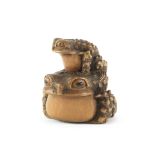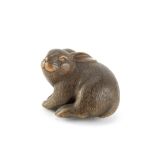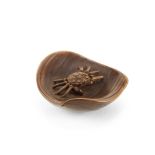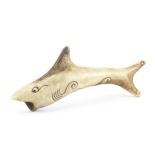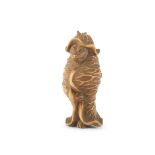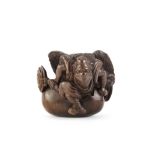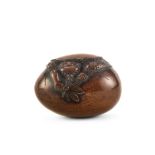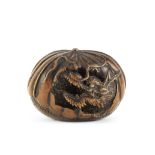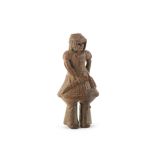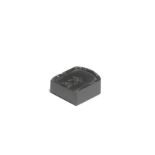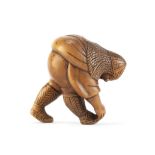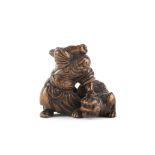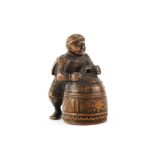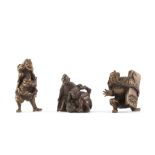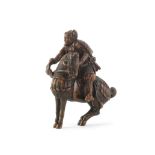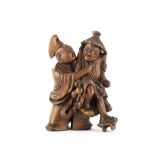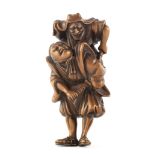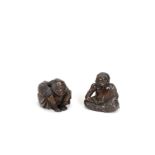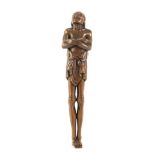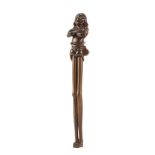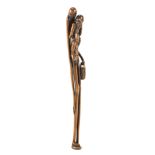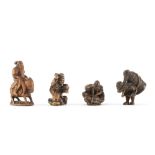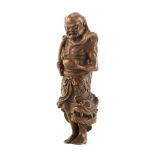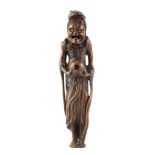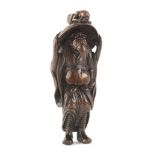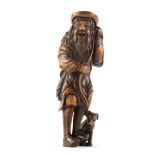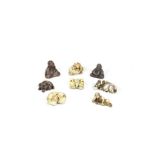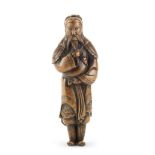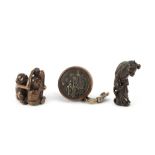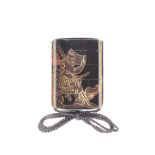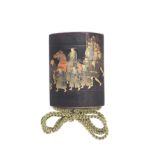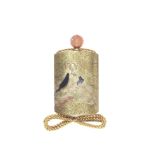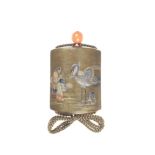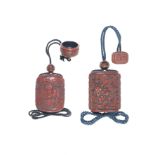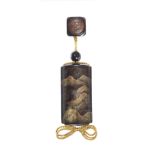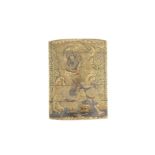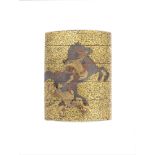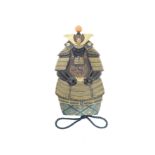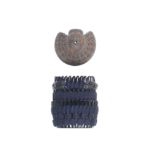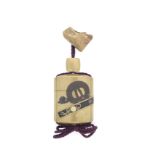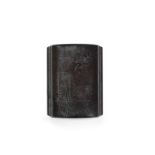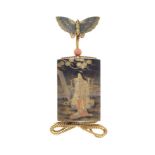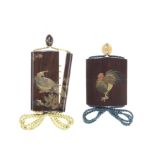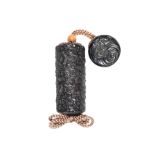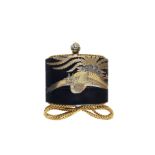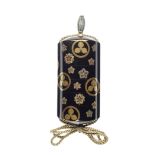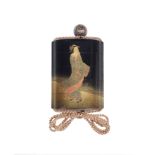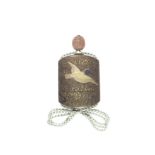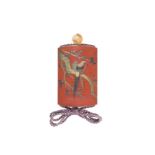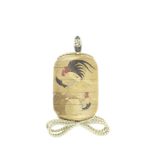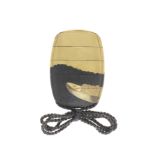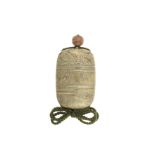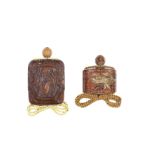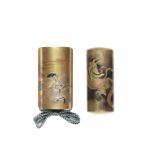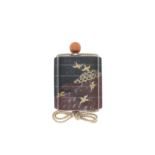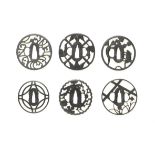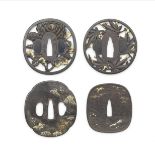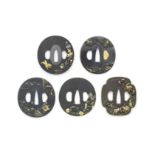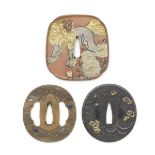Refine your search
Filtered by:
- Category
- List
- Grid
A subscription to the Price Guide is required to view results for auctions ten days or older. Click here for more information
A wood netsuke of two toads By Masanao, Yamada, Ise Province, Edo period (1615-1868), 19th century
A wood netsuke of two toadsBy Masanao, Yamada, Ise Province, Edo period (1615-1868), 19th century A large toad seated in a typical attitude, a sma...
A wood netsuke of a rabbit By Ichibun, Edo period (1615-1868) or Meiji era (1868-1912), 19th cen...
A wood netsuke of a rabbitBy Ichibun, Edo period (1615-1868) or Meiji era (1868-1912), 19th centurySeated, its head turned to the left and one hin...
A boxwood netsuke of a crab in a chestnut By Miyazaki Joso (1835-1910) of Tokyo, Meiji era (1868...
A boxwood netsuke of a crab in a chestnutBy Miyazaki Joso (1835-1910) of Tokyo, Meiji era (1868-1912), late 19th centuryThe crustacean crawling ov...
A Stag antler netsuke of a sharkEdo period (1615-1868) or Meiji era (1868-1912), mid-late 19th centuryNaturalistically rendered with incised detai...
A pale boxwood netsuke of a badger Edo period (1615-1868) or Meiji era (1868-1912), mid-late 19t...
A pale boxwood netsuke of a badgerEdo period (1615-1868) or Meiji era (1868-1912), mid-late 19th centuryStanding and staring ahead in a human atti...
A Wood netsuke of Sojobo (the tenju king) hatching Edo period (1615-1868), mid-late 19th century
A Wood netsuke of Sojobo (the tenju king) hatchingEdo period (1615-1868), mid-late 19th centuryShown emerging from a large shell, one hand clutchi...
A boxwood netsuke of tengu no tamago (hatching tengu) Edo period (1615-1868), late 18th/early 19t...
A boxwood netsuke of tengu no tamago (hatching tengu)Edo period (1615-1868), late 18th/early 19th centuryThe karasu (crow-beaked) tengu shown clut...
A netsuke of a dragon in a chestnut By Toyoyasu (Toyoyo), Edo period (1615-1868), Sasayama, Tanba...
A netsuke of a dragon in a chestnutBy Toyoyasu (Toyoyo), Edo period (1615-1868), Sasayama, Tanba Province, 19th centuryThe small chestnut naturali...
A Wood netsuke of a haniwa warrior By Ouchi Sosui (1911-1972), Showa era (1926-1989), 20th century
A Wood netsuke of a haniwa warriorBy Ouchi Sosui (1911-1972), Showa era (1926-1989), 20th centuryRendered in conventional form, standing, wearing ...
A black-lacquered netsuke in the form of a broken-off piece of ink By Shibata Zeshin (1807-1891),...
A black-lacquered netsuke in the form of a broken-off piece of inkBy Shibata Zeshin (1807-1891), Meiji era (1868-1912), late 19th centuryDecorated...
A wood netsuke of a soldierBy Bokusan Sekko, Edo period (1615-1868), mid-19th centuryProbably representing a foreign soldier, wearing a conical ha...
A wood netsuke of Hadesu slaying a tigerBy Tsuguhisa, Edo period (1615-1868), 19th centuryThe legendary warrior standing in a belligerent pose wit...
A Wood netsuke of Benkei and the bell of MiideraEdo period (1615-1868), early 19th centuryThe warrior shown leaning forward and putting all his fo...
Three wood okimono netsuke Edo period (1615-1868) or Meiji era (1868-1912), late 19th/early 20th...
Three wood okimono netsukeEdo period (1615-1868) or Meiji era (1868-1912), late 19th/early 20th centuryComprising: Omori Hikoshichi and Chihaya, t...
A wood okimono of a samurai on horseback Edo period (1615-1868) or Meiji era (1868-1912), late 19...
A wood okimono of a samurai on horsebackEdo period (1615-1868) or Meiji era (1868-1912), late 19th/early 20th centuryThe warrior wearing a full su...
A wood group netsuke of Taira no Tadamori apprehending the oil thief Edo period (1615-1868), late...
A wood group netsuke of Taira no Tadamori apprehending the oil thiefEdo period (1615-1868), late 18th/early 19th centuryThe former standing barefo...
A wood netsuke of Omori Hikoshichi and Chihaya Edo period (1615-1868), late 18th/early 19th century
A wood netsuke of Omori Hikoshichi and ChihayaEdo period (1615-1868), late 18th/early 19th centuryThe warrior standing and bending over from the w...
Six various netsuke and okimonoMeiji era (1868-1912), late 19th/early 20th centuryComprising three of wood, one ceramic and two ivory netsuke: the...
A Tall wood sashi netsuke of Ashinaga By Masanao of Ise, Yamada, Edo period (1615-1868) or Meiji ...
A Tall wood sashi netsuke of AshinagaBy Masanao of Ise, Yamada, Edo period (1615-1868) or Meiji era (1868-1912), mid-late 19th centuryStanding, lo...
A Tall wood sashi netsuke of Ashinaga By Masanao of Ise, Yamada, Edo period (1615-1868) or Meiji...
A Tall wood sashi netsuke of AshinagaBy Masanao of Ise, Yamada, Edo period (1615-1868) or Meiji era (1868-1912), mid-late 19th centuryStanding wit...
A tall wood sashi netsuke of Ashinaga and TenagaEdo period (1615-1868), 19th centuryAshinaga (long legs) standing with one foot pinning down a tu...
Four wood various figure netsukeEdo period (1615-1868), late 18th/early 19th centuryComprising: Kan'u riding a horse, unsigned; 5.2cm (2in) high; ...
A Tall wood netsuke of Handaka SonjaEdo period (1615-1868), mid-late 19th centuryStanding barefoot with eyes downcast, dressed in mugwort cloak an...
A Tall wood netsuke of Ryujin's assistant Edo period (1615-1868), late 18th/early 19th century
A Tall wood netsuke of Ryujin's assistantEdo period (1615-1868), late 18th/early 19th centuryStanding with a pained expression, holding the tide-r...
A wood netsuke of Shoki and oni (demon)Edo period (1615-1868), late 18th/early 19th centuryThe demon-queller standing, holding his broad hat with ...
A Tall wood netsuke of a Dutchman and dogBy Ikko, Edo period (1615-1868), 19th centuryStanding and smiling, dressed in a traditional three-quarter...
A group of 22 various netsuke Edo period (1615-1868) or Meiji era (1868-1912), late 19th to early...
A group of 22 various netsukeEdo period (1615-1868) or Meiji era (1868-1912), late 19th to early 20th centuryComprising: two of professional sneez...
A tall wood netsuke of Kan'uEdo period (1615-1868), late 18th centuryThe Chinese general standing in a typically dignified attitude, stroking his ...
Three wood netsuke and one stag-antler kiseruzutsu (pipe case) Edo period (1615-1868), early to ...
Three wood netsuke and one stag-antler kiseruzutsu (pipe case)Edo period (1615-1868), early to late 19th centuryComprising: Ashinaga and Tenaga re...
A lacquer three-case inroEdo period (1615-1868), 16th/17th centuryThe roiro ground lacquered with a continuous scene in gold and slightly coloured...
A black-lacquer four-case inro By Koma Kyuhaku, Edo period (1615-1868), late 18th/early 19th cen...
A black-lacquer four-case inroBy Koma Kyuhaku, Edo period (1615-1868), late 18th/early 19th centuryThe roiro ground finely decorated in gold, silv...
A gold lacquer and metal-inlaid four-case inro By a member of the Koma Family and Naka Komin, Edo...
A gold lacquer and metal-inlaid four-case inroBy a member of the Koma Family and Naka Komin, Edo period (1615-1868) or Meiji era (1868-1912), 19th...
A gold-lacquer three-case inroBy Toju, Edo period (1615-1868), 19th centuryThe fundame ground decorated in gold, silver and iro-e takamaki-e with ...
Two carved red-lacquer inro One by Shin'yu, Edo period (1615-1868), late 18th/early 19th century...
Two carved red-lacquer inroOne by Shin'yu, Edo period (1615-1868), late 18th/early 19th centuryBoth carved in relief, the first oval and of two ca...
A lacquered four-case inroEdo period (1615-1868), late 18th/early 19th centuryDecorated in gold togidashi maki-e and e-nashiji with a continuous s...
A rare iron inro in the form of a kabuto (helmet)Edo period (1615-1868), 19th centuryThe shallow rounded bowl overlaid with silver ridges and surm...
A gold-lacquer broad four-case inro Edo period (1615-1868) or Meiji era (1868-1912), mid-late 19t...
A gold-lacquer broad four-case inroEdo period (1615-1868) or Meiji era (1868-1912), mid-late 19th centuryThe obirame ground lavishly decorated in ...
A gold lacquer four-case inro By the Kajikawa family, Edo period (1615-1868) or Meiji era (1868-1...
A gold lacquer four-case inroBy the Kajikawa family, Edo period (1615-1868) or Meiji era (1868-1912), 19th centuryBearing a rich oki-birame ground...
A gold-lacquer large three-case inro in the form of a suit of armour By Shokasai, Edo period (161...
A gold-lacquer large three-case inro in the form of a suit of armourBy Shokasai, Edo period (1615-1868), 19th centuryThe suit of armour displayed ...
A lacquered kinchaku (pouch) and iron netsuke in the form of a kabuto (helmet) The kinchaku by Sh...
A lacquered kinchaku (pouch) and iron netsuke in the form of a kabuto (helmet)The kinchaku by Shigeyoshi; both pieces Edo period (1615-1868), 19th...
A gold-lacquer two-case inro with a gold-lacquer square ojime in form of a shamisen and a cherry ...
A gold-lacquer two-case inro with a gold-lacquer square ojime in form of a shamisen and a cherry wood netsukeThe inro probably by Komai Kansai II ...
A yamimaki-e (black-on-black) lacquer four-case inro By a member of the Kajikawa family, Edo peri...
A yamimaki-e (black-on-black) lacquer four-case inroBy a member of the Kajikawa family, Edo period (1615-1868), 19th centuryThe rich roiro ground ...
A black and gold lacquer four-case inroEdo period (1615-1868), mid-19th centuryThe roiro ground embellished with mura-nashiji, finely lacquered in...
Two lacquered-wood inro One by Koma Kansai and one by Iizuka Toyo IV (Toshu), Edo period (1615-1...
Two lacquered-wood inroOne by Koma Kansai and one by Iizuka Toyo IV (Toshu), Edo period (1615-1868), 19th centuryEach lacquered in gold and slight...
A wood slender upright three-case inro By Yamashita Tsuneyoshi, Edo period (1615-1868), 19th cen...
A wood slender upright three-case inroBy Yamashita Tsuneyoshi, Edo period (1615-1868), 19th centuryCarved throughout in varying degrees of relief ...
A black-lacquer broad two-case inro By Tatsuke Takamitsu, Edo period (1615-1868), mid-19th century
A black-lacquer broad two-case inroBy Tatsuke Takamitsu, Edo period (1615-1868), mid-19th centuryThe rich roiro ground lacquered in gold takamaki-...
A black-lacquer five-case inroBy Koma Bunsai, Edo period (1615-1868), mid-19th centuryOf upright form, the rich roiro ground lacquered with scatte...
A black lacquer four-case inro By Shojusai, Edo period (1615-1868) or Meiji era (1868-1912), 19th...
A black lacquer four-case inroBy Shojusai, Edo period (1615-1868) or Meiji era (1868-1912), 19th centuryBearing a roiro and e-nashiji ground, lac...
A gold-lacquer small three-case inro By Minsetsu, Edo period (1615-1868) or Meiji era (1868-1912...
A gold-lacquer small three-case inroBy Minsetsu, Edo period (1615-1868) or Meiji era (1868-1912), 19th centuryThe usu-nashiji ground embellished w...
A red-lacquer four-case inroBy Koma Yasutada, Edo period (1615-1868), mid-19th centuryThe vertical rectangular body embellished red, gold and silv...
A gold-lacquer four-case inroMeiji era (1868-1912), late 19th/early 20th centuryThe kinji ground decorated in gold and slightly coloured takamaki-...
A gold-lacquer four-case inro By Shibata Zeshin (1807-1891), Meiji era (1868-1912), late 19th ce...
A gold-lacquer four-case inroBy Shibata Zeshin (1807-1891), Meiji era (1868-1912), late 19th centuryThe lenticular cross-section with rounded corn...
A gold-lacquer oval four-case inroBy Yukasai, Meiji era (1868-1912), late 19th centuryDecorated in gold takamaki-e and kirikane with an all-over d...
A carved wood two-case inro and a lacquer two-case inro Edo period (1615-1868) or Meiji era (1868...
A carved wood two-case inro and a lacquer two-case inroEdo period (1615-1868) or Meiji era (1868-1912), late 19th/early 20th centuryThe first carv...
A gold-lacquer saya (sheath) five-case inro Meiji era (1868-1912), late 19th/early 20th century (2)
A gold-lacquer saya (sheath) five-case inroMeiji era (1868-1912), late 19th/early 20th centuryThe saya decorated in gold, grey, and black takamaki...
A black-lacquer small four-case inro By Shibata Zeshin (1807-1891), Meiji era (1868-1912), late 1...
A black-lacquer small four-case inroBy Shibata Zeshin (1807-1891), Meiji era (1868-1912), late 19th centuryDecorated with chidori (dotterels or pl...
Nine iron sukashi (openwork) tsuba (sword guards) Momoyama (1573-1615) and Edo (1615-1868) period...
Nine iron sukashi (openwork) tsuba (sword guards)Momoyama (1573-1615) and Edo (1615-1868) period, late 16th to 19th centuryUnsigned and circular e...
Eight iron tsuba (sword guards)Edo period (1615-1868), 18th/19th centuryThe first circular, pierce carved and modelled as a chrysanthemum plant (g...
Five shakudo tsuba (sword guards)Edo period (1615-1868), late 18th/19th centuryAll except the fifth almost circular, the first with nanako ground,...
Three tsuba (sword guards) Edo period (1615-1868) and Showa era (1926–1989), 19th/20th century (6)
Three tsuba (sword guards)Edo period (1615-1868) and Showa era (1926–1989), 19th/20th centuryThe first brightly patinated copper mokko with a hamm...

